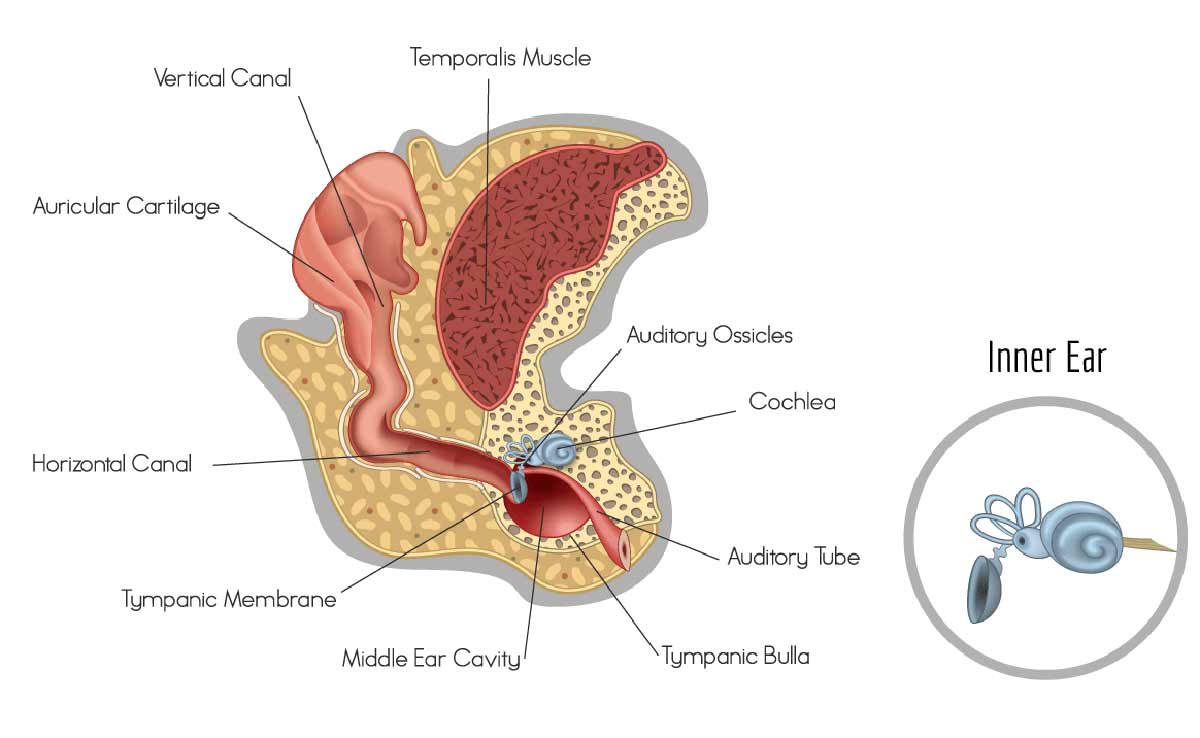
To keep the lights on, we receive affiliate commissions via some of our links. Our review process.
Ear infections in dogs are common and one of the top reasons you may need to seek veterinary treatment for your canine friend. As many as 20% of dogs have some form of ear disease. Dogs are more prone to ear infections than humans because of the shape of their ears. Many dog owners have learned to recognize the first signs of an ear infection in their dog, such as scratching, head shaking, and whining. Let’s find out more about how to spot this common disease, what treatment options are available, and when medication such as antibiotics are needed.

Symptoms Of Dog Ear Infections
Contents
Some dogs do not show signs of discomfort with an ear infection, and the only external signs are a build-up of wax and discharge in the ear canal. Ear infections can affect one or both ears at the same time. Common signs of an ear injection include:
- Head-Shaking
- Scratching at the ears
- Dark wax or discharge in the ear canal
- Foul smelling odor
- Redness and swelling of the ear canal
- Pain when the ear is touched or reluctance to allow the ear to be touched
- Head tilt to the side, which is worst affected
What Causes Ear Infections In Dogs?
Ear infections in dogs can occur in the outer ear (otitis externa), the middle ear (otitis media), or the inner ear (otitis interna). Dogs have a long ‘L’-shaped ear canal that easily traps dirt and moisture.
Breeds with long, floppy ears or dogs that love to swim frequently are more susceptible to ear problems, but any breed of dog can be affected. Ear infections in the outer ear (otitis externa) are often caused by bacteria that live in the ear canal normally and help keep the skin balanced and healthy.
Something triggers the ear canal to become inflamed, allowing bacteria and yeast populations to become unbalanced and overgrown, resulting in an ear infection. Tiggers for ear infections in dogs include allergies (environmental allergies such as pollens and grasses or food allergies are common), parasites such as ear mites, foreign objects in the ear canal such as grass seeds, and growths or tumors in the ear canal.

How Are Dog Ear Infections Diagnosed?
If your dog is showing signs of an ear infection, it is important to visit your vet as soon as possible. Prompt treatment is important to prevent the spread of infection to the middle and inner ear. Your vet will take a history to establish any underlying allergies or triggers such as swimming, grooming, or cleaning the ears.
Examination of the ears may involve visualizing the ear canal and eardrum with an otoscope and palpation of the ears to assess pain. Swab samples from the ear may be taken for microscopic examination or culture. In severe or chronic cases, biopsies, x-rays, or a CT scan of the ear canals may be needed.
For some dogs with an ear infection, even gentle palpation of the ear canal is painful. For this reason, your vet may advise that his or her ears are examined under sedation to allow appropriate examination of the ear canal without causing pain or stress.
How Are Dog Ear Infections Treated?
Ear infections can vary in severity and underlying cause. This determines how ear infections are treated and how quickly they resolve. For some dogs, especially those with underlying skin allergies, ear infections can become a chronic problem and require lifelong management. Treatment of outer ear infections commonly involves cleaning your dog’s ears to remove wax and discharge using a medicated ear cleanser alongside topical medication. Topical medication may include anti-inflammatory drugs such as steroids to reduce inflammation, antibiotics if a bacterial infection is present and antifungal drugs if a yeast infection is present. In chronic cases, ear flushes under sedation or general anesthesia are performed to remove wax and discharge and instill medication into the ear canal.
When Are Antibiotics Needed For Dog Ear Infections?
Inflammation of the ear canal (otitis externa) may result in the overgrowth of yeast or bacterial populations that live on the skin in the ear canal normally. Antibiotics are needed for ear infections where bacterial overgrowth is identified. Not all ear infections require antibiotics. Your vet can advise on the best treatment based on their examination and diagnostic tests. It is important to follow your vet’s instructions closely and return for any recommended recheck appointments to ensure the infection has resolved completely. Lapses in your dog’s treatment could lead to a recurrence of the infection.
How Do Antibiotics Work?
Antibiotics are medications that can be used to treat bacterial infections. Antibiotics kill bacteria by damaging their structure or preventing them from multiplying. Antibiotics do not have different ‘strengths’ but instead target different populations of bacteria. Broad spectrum antibiotics kill a wide range of bacteria, whereas narrow spectrum antibiotics target small groups of bacteria. Antibiotics can be administered in different forms.
For middle ear infections (otitis media), it is most likely that they are given orally in tablet or liquid form or by injection. Outer ear infections (otitis externa) are often treated with antibiotic ear drops. Some antibiotic ear drops for dog ear infections are given every day (up to three times per day) into the ear canal whereas others are administered as a ‘depo’ preparation in a gel that is placed in the ear canal and continues to work for up to 4 weeks.
Antibiotics only kill bacteria and are not useful for other types of ear infections caused by yeast or fungi. Antibiotics for dog ear yeast infection is not a useful treatment. Antifungal ear drops are more appropriate. Your vet might often perform tests on samples taken from your dog’s ear to determine if antibiotic treatment is needed for an ear infection.
Is Antibiotic Resistance A Concern For Dog Ear Infections?
Yes, antibiotic resistance is a huge concern and poses a serious threat to humans and dogs. Since antibiotics have been discovered, infections have been much easier to treat, but we must use them carefully. Otherwise, bacteria become resistant to their effects. The more antibiotics we use, the more bacteria get used to them and find ways to resist them.
If your dog’s ear infection is not responding to an initial course of treatment, your vet may take a sample of the infection for a test called culture and sensitivity. This involves growing, or culturing, the bacteria in a lab and testing the activity of common antibiotics against it to identify resistance and choose the most suitable antibiotic for that specific infection.
What Can I Do To Prevent Antibiotic Resistance?
Actions dog owners can take to reduce the growing problem of antibiotic resistance include:
- Administer oral antibiotics, or antibiotic ear drops at the correct time and at the correct dose. Read dosing instructions on the dispensing label carefully.
- Always complete the course of your dog’s antibiotic, even if they seem better before the end. Antibiotic ear drops should always be used as a course and not applied to your dog’s ear intermittently.
- Do not use antibiotic ear drops for repeat ear infections unless they have been prescribed by your vet for this. Even if the symptoms appear the same, the infection may be different.
- Dispose of unused antibiotics safely. Do not put them in household waste or water sources as this could lead to environmental contamination.
What Are The Best Antibiotics For Dog Ear Infections?
One antibiotic is not ‘better’ or ‘stronger’ than another antibiotic drug. The best antibiotic to use to treat a dog’s ear infection is one that has the narrowest spectrum of activity against the specific bacteria involved in the ear infection. Diagnostic tests performed on ear swab samples can help to determine the most appropriate antibiotic to use to treat your dog’s ear infection and for how long. The best oral antibiotics for dog ear infections can then be prescribed, or topical antibiotics in the form of ear drops.
Are There Alternatives To Antibiotics For Dog Ear Infections?
If your dog is showing signs of an ear infection, it is important to seek veterinary advice. Do not be tempted to try and treat the ear infection at home as the infection could progress, leading to more serious problems such as a ruptured ear drum, middle ear infections, abscesses around the ear, or inner ear infections. Not all ear infections require antibiotics.
Your vet can advise on the most appropriate treatment. Ear cleansers that contain antibacterial ingredients or change the acidity of the ear canal can be used to control mild ear infections. For some infections, controlling the inflammation and removing the underlying cause (such as a foreign body in the ear canal, allergies, or ear mites) is enough to allow the infection to resolve without antibiotics.
Ear infections can be painful and uncomfortable for our canine friends, so naturally, we want to resolve them as fast as possible. Seek veterinary advice promptly if you notice signs of infection with your dog’s ear and follow the advice carefully to avoid problems or recurring infections. Antibiotics can be a safe and effective treatment for ear infections in dogs. However, they are not always needed. We all have a role to play in ensuring the safe and responsible use of antibiotics and in limiting serious problems such as antibiotic resistance.
Tagged With: Ears